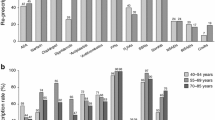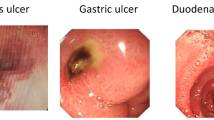Abstract
Background: Nonsteroidal anti-inflammatory drugs (NSAIDs) are known to increase the risk of upper gastrointestinal bleeding (UGIB). Whether the severity of outcome of UGIB associated with NSAIDs differs from non-NSAID-related UGIB is less clear.
Method: Medical records of 228 patients hospitalized for UGIB in the Danish county of North Jutland were evaluated. Preadmission characteristics and clinical outcomes were compared between 112 patients who had been prescribed ibuprofen and 116 patients who had been prescribed paracetamol within 90 days of the hospitalization.
Results: The baseline characteristics of UGIB patients prescribed ibuprofen tended to differ from those prescribed paracetamol. The ibuprofen group significantly less often had histories of ulcer (11% vs 36%) and dyspepsia (19% vs 44%), or had been prescribed medications for these or other conditions, and had lower co-morbidity indices. Ibuprofen users also were somewhat less likely (31% vs 37%) to report GI pain at admission, but among hospitalized patients with endoscopic examinations were more likely (75% vs 58%) to be diagnosed with ulcer or hematemesis vs normal or gastritis/dyspepsia/reflux. For the clinical outcomes, 30 days case fatality rates were 12% for both ibuprofen and paracetamol users. The ibuprofen-related cases of UGIB more often required surgery (11% vs 3%) or transfusions (66% vs 57%), and those prescribed ibuprofen averaged 11 days in hospital, 4 days longer than those prescribed paracetamol. Adjustment for baseline characteristics and underlying conditions, or analyses eliminating patients with unconfirmed diagnoses and prior ulcers or restricted to patients with current hospital diagnoses of ulcer or hematemesis, did not materially alter the ibuprofen vs paracetamol differences in outcome measures. Generally similar results were obtained when restricting the analyses to patients prescribed ibuprofen or paracetamol within 30 days of UGIB hospitalization, except for a reduction in the 30 days case fatality rate among those prescribed ibuprofen.
Conclusions: UGIB patients with antecedent ibuprofen prescriptions experienced about the same case fatality rates, but more surgery and longer hospital stays, than patients prescribed paracetamol. The differences appear in part due to differing characteristics among those prescribed ibuprofen compared with those prescribed paracetamol, but also raise the possibility of drug-related effects.
Similar content being viewed by others
References
Hawkey CJ. Non-steroidal anti-inflammatory drugs and peptic ulcers. BMJ 1990; 300: 278–84.
Gabriel S, Jaakkimainen L, Bombardier C. Risk for serious gastrointestinal complications related to use of nonsteroidal anti-inflammatory drugs: a meta-analysis. Ann Intern Med 1991; 115: 787–96.
Hernandez Diaz S, Garcia Rodriguez LA. Association between nonsteroidal anti-inflammatory drugs and upper gastrointestinal tract bleeding/perforation: an overview of epidemiologic studies published in the 1990s. Arch Intern Med 2000; 160: 2093–9.
Wilcox CM, Clark WS. Association of nonsteroidal antiinflammatory drugs with outcome in upper and lower gastrointestinal bleeding. Dig Dis Sci 1997; 42: 985–9.
Llorente Melero MJ, Tenias Burillo JM, Del Val Antonana A, Zaragoza Marcet A. Influence of nonsteroidal anti-inflammatory drugs on clinical course in upper gastrointestinal tract bleeding. Rev Esp Enferm Dig 1999; 7: 497–507.
Henry DA, Johnston A, Dobson A, Duggan J. Fatal peptic ulcer complications and the use of non-steroidal antiinflammatory drugs, aspirin, and corticosteroids. BMJ 1987; 295: 1227–9.
Bliss DW, Stabile BE. The impact of ulcerogenic drugs on surgery for the treatment of peptic ulcer disease. Arch Surg 1991; 126: 609–12.
Laszlo A, Kelly JP, Kaufman DE, Sheehan JE, Retsagi G, Wilholm BE et al. Clinical aspects of upper gastrointestinal bleeding associated with use of nonsteroidal antiinflammatory drugs. Am J Gastroenterol 1998; 93: 721–5.
Vreeburg EM, de Bruijne HW, Snel P, Bartelsman JH, Rauws EA, Tytgat GN. Previous use of non-steroidal anti-inflammatory drugs and anticoagulants: the influence on clinical outcome of bleeding gastroduodenal ulcers. Eur J Gastroenterol Hepatol 1997; 9: 41–4.
Armstrong CP, Blower AL. Non-steroidal anti-inflammatory drugs and life threatening complications of peptic ulceration. Gut 1987; 28: 527–32.
Peoples JB. Peptic ulceration and the nonsteroidal anti-inflammatory drugs. Am Surg 1985; 51: 358–62.
Keating J, Chandran H. Antiinflammatory drugs and emergency surgery for peptic ulcers in the Waikato. NZ Med J 1992; 105: 127–9.
Andersen TF, Madsen M, Jorgensen J, Mellemkjaer L, Olsen JH. The Danish National Hospitalization Register: valuable resource data for modern health sciences. Dan Med Bull 1999; 46: 263–4.
Nielsen GL, Sorensen HT, Zhou W, Steffensen FH, Olsen JH. Pharmacologic prescription database of North Jutland: a valid tool in pharamacoepidemiologic research. Int J Risk Safety Med 1997: 10: 203–5.
Breslow NE, Day NE. Statistical methods in cancer research. Vol 1. Analysis of case-control studies, IARC Sci Pub 32. Lyon, France, 1980.
Statistical Analysis System, Cary North Carolina; 2001.
Charlson ME, Pompei P, Ales KL, MacKenzie CR. A new method of classifying prognostic comorbidity in longitudinal studies: development and validation. J Chron Dis 1987; 40: 373–83.
Mellemkjaer L, Blot WJ, Sorensen HT, Thomassen L, McLaughlin JK, Nielsen GL et al. Upper gastrointestinal bleeding among users of NSAIDs: a population-based cohort study in Denmark. Br J Clin Pharmacol 2002; 53: 173–81.
Author information
Authors and Affiliations
Corresponding author
Rights and permissions
About this article
Cite this article
Blot, W.J., Fischer, T., Nielsen, G.L. et al. Outcome of upper gastro-intestinal bleeding and use of ibuprofen versus paracetamol. Pharm World Sci 26, 319–323 (2004). https://doi.org/10.1007/s11096-004-9008-5
Issue Date:
DOI: https://doi.org/10.1007/s11096-004-9008-5




